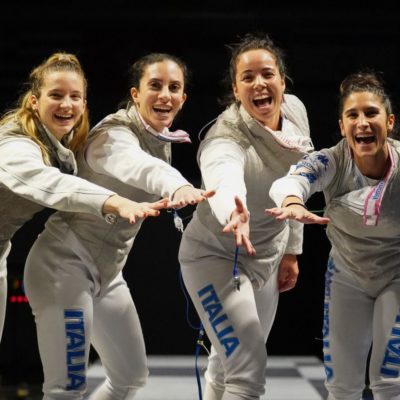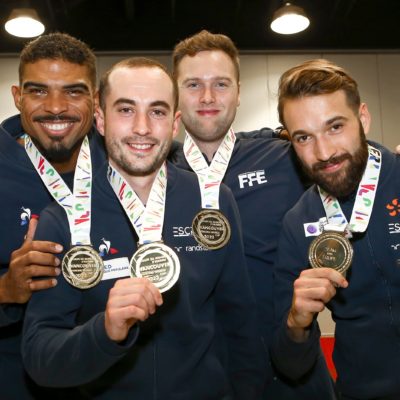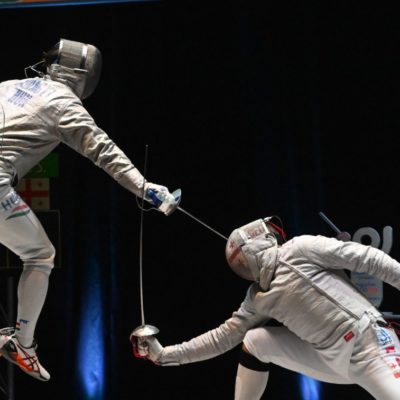Most people want to leave their high school years far behind them. For Director (and International USA Fencing competitor) Holly Buechel—whose High School Fencing experience lead her to a post-collegiate career in both serious documentary filmmaking and serious competitive Fencing—the last place she thought either would take her was right back where she started.
Fencing For The Edge follows four New Jersey High School Fencing teams as they compete with and against each other—and impending college applications—through the 2013-2014 High School Fencing season. With filming now wrapped up, director Buechel has moved into the editing phase of the project and is currently running a verified Non-Profit Indiegogo campaign to crowdsource the funds needed to complete production and release the film as her first full-length feature documentary.
With eleven days left in the campaign, I had the wonderful opportunity to talk to Buechel about the film’s background and some of the challenges she faced during the filmmaking process. She was also kind enough to put together a teaser for us, featuring Columbia High School, which you can find at the end of this article.
Madison Lynn Haughie, Fencing.Net: Where did you get the idea to make a documentary about High School Fencing?
Holly Buechel: “While I was watching myself fence at film festivals in my first short, Speed of Fencing, I was reflecting about when I first started fencing and how far I had come since high school. I come from New Jersey where Fencing is just a regular high school sport you can play. When I signed up for Fencing at Oak Knoll Scholl, everyone was awkward at first but it was ok. We all learned as a group and helped each other which was really special to me and gave me a lot of confidence.

“After fencing at the University of Pennsylvania, I returned home and started coaching at Columbia High School and saw what these kids go through from an adult perspective. There’s so much excitement in one high school season, it felt very similar to my college NCAA experience. After coaching, I went to grad school at the City College of New York for Film Editing and found that I focused a few of my assignments on fencing and was drawn to documentary films. One documentary I watched followed a swimmer competing through a college season and I thought, “You could totally do that for a fencing season. I could do that with New Jersey’s high schools!” I also knew there was a new enthusiasm for fencing that had grown in New Jersey from 30 teams to 60 teams ten years later. I wondered How that had happened? Who were the best teams now? Why were so many kids Fencing? So I decided to start pre-production on a documentary about high school Fencing in New Jersey to tell a story similar to my experience in the beginnings of the sport, following one season and hopefully ending up in the finals with my teams.”
FdN: So why did you decide to call it “Fencing For The Edge”?
Holly Buechel: “Titles are a tough thing for films because you are trying to hint at what the film is about in an intriguing way. There’s lot of words for fencing that aren’t modern fencing words, like “sword,” “duel,” and “touché” that I didn’t want to use. I  wanted to play on the word “edge” because there are lots of meanings it can have, depending on the context. The “edge” in the film speaks about the advantage you can get on a college application, an emotional high from victory, the love of the sport, and plays on the different kinds of blades in fencing. I’ve left it open for interpretation.”
wanted to play on the word “edge” because there are lots of meanings it can have, depending on the context. The “edge” in the film speaks about the advantage you can get on a college application, an emotional high from victory, the love of the sport, and plays on the different kinds of blades in fencing. I’ve left it open for interpretation.”
FdN: What did you want to accomplish with this documentary? Were there any specific goals you had when you started filming, and did anything change during the process?
Holly Buechel: “Our main goal is to exposure the sport of fencing to a broader audience. When I started the documentary, we followed one student for a high school season. It was a very personal journey which we loved but we were missing something. We couldn’t get access to his team’s practices, we weren’t able to film in the school, and I felt locked out of the elements that were shaping his fencing story. I went back to the school I coached and connected with some coaches that year to begin the process of obtaining permission from high schools to film the team aspect of fencing.

Courtesy of Holly Buechel
“We also had to get clearance from the New Jersey State Interscholastic Athletic Association (NJSIAA) and the NJ Division, which we did and found great support. In my research, I learned that the 2013-14 season was going to be 50th anniversary season of the NJSIAA fencing tournament and that confirmed my intuition to continue the project. So we filmed a second year with four teams in the state with varying sizes, races, socioeconomic backgrounds, and skill levels at practices, tournaments, and some time at their schools.
“I tried to predict the winners, but the main challenge was to be flexible in the filming schedule. Out of the four teams we filmed, Columbia and Bernards girls ended up in the finals together in a dramatic showdown, which is always great for a film. Teaneck and Pingry had average seasons but enjoyed the sport more in the way I had first experienced it. It was really difficult to follow four teams, and I’m probably nuts for attempting it for my first feature film, but I wanted variety and different reasons why fencing impacts people. I ended up filming a lot by myself because there was so much going on all the time and my budget didn’t allow for a crew everyday.”
Madison Lynn: What was your most memorable day of filming? Did you have any bad days?
Holly Buechel: “The most memorable day was definitely the night of the State Team Finals. I was so nervous; it felt like I was going to fence! I wore my Bernards Fencing t-shirt and my Columbia Fencing flannel pants to bed the night before and even went to yoga in the morning to relax. It was terrible because I knew someone was going to lose and I was going to feel sad for someone either way. When the meet started, I had a lot of crew with me to cover both the Girls and Boys matches so I was focusing on the scores and where my people were.
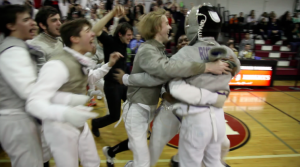
“The Columbia Boys match with Ridge ended much quicker than anyone predicted. There were a lot of 4-4 bouts but Columbia kept winning them. When they were approaching the 14th victory, I had extra eyes on the bouts to capture that moment of team victory. It’s like winning the Super Bowl for these kids! The Girls meet was much closer and the score kept trading a bout here and there. It was going into the last round of Epée and I set up my crew to catch the moment of victory, which is easy and exciting, while I had my own camera getting the sad moments of defeat. For me, that was difficult because I feel personally connected to these teams and I didn’t want anyone to lose. But in the end, there has to be a winner.
“We never had a “bad” day. There were days with more technical difficulties than others. Days where it snowed or were so cold my car had trouble starting. It runs the range with documentary because you can’t control reality. We aren’t making a scripted film where all the actors are reading lines and our lighting is perfect because we set the stage hours before. So a bad day was when the obstacles of film making were so great that it made it difficult to capture the action we had hoped.
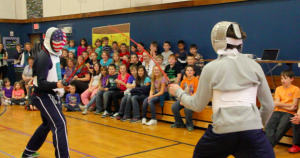
“My worst day was filming at the District 3 qualifiers and then trying to catch a flight to Atlanta that night to film with Tim Morehouse the next morning. I had gotten a stomach flu or was just run down and was barely standing throughout the day-long tournament in Livingston. Columbia was the team we were following that day and they were doing well as usual. The tournament was run on time but I still had to film the awards ceremony and take my crew to the Newark train station. I got them back and went to meet my sister to drive me to the airport when I just collapsed from exhaustion. We were driving to La Guardia Airport in New York and we hit the worst traffic I’ve ever seen. I missed my flight by an hour so we drove to my apartment on the Upper East Side. I slept for 5 hours before attempting the airport run again in the morning. I made the first flight to Atlanta and met up with Tim while he was in the middle of a presentation for Fencing In The Schools. Missing that flight was probably the best thing that could have happened because I was clearly fatigued and I could sleep in my own bed for a few hours. I filmed the rest of the day with Tim in Atlanta and met some nice Pope High School Epée fencers, the highlight of the trip for me.”
FdN: You compete at the international level, but you were also a collegiate and high school fencer. How would you compare the experiences you had in your high school league to the students in your film?
Holly Buechel: “When I was in high school, it wasn’t unusual for a fencer to start in high school and become a state champion in four years or less. Today, I see more fencers starting younger and competing year-round in one sport. We used to be in awe the fencers who went to Junior Olympics but now you see kids making the Cadet and Junior World teams from New Jersey all the time. This also means that some kids are choosing between international competitions and high school meets. That was never an option in my high school time, but it shows the improving strength of the sport.
“The experience of high school fencing is pretty much the same. You have athletic kids with nerdy kids all trying to figure out this asymmetric sport and identify with a weapon that suit their personality. We had pizza parties, sleepovers, bus ride songs, team huddles, and lots of footwork together. There’s a lot of bonding that happens off the strip, which was true in college and internationally too. The friends I’ve made in fencing are still some of my closest friends today!”
FdN: What do you think is the biggest obstacles for growing high school fencing? What about the growth of fencing in general?
Holly Buechel: “One of the questions I’ve been trying to answer with this film is how to grow the sport at the high school level. New Jersey is the success story if everything falls perfectly together at the right time. But how do you start something like a high school league if you haven’t had it since the 1930s? One solution we explored involved following Tim Morehouse’s Fencing In The Schools program. Tim is trying to get fencing into gym classes using simplified equipment he developed that simulates fencing with a buzzing light on the vest and plastic foils. The first problem with fencing is the lack of exposure and knowledge about the sport. If you can introduce fencing in a simple way, there is a greater chance for understanding.
“Another problem for high school fencing in other states is that it is not recognized as a varsity sport. States like Georgia and North Carolina have fencing club teams and championships but are struggling to grow because they don’t receive the same funding that other varsity sports get from their school. If schools could properly fund their programs, the sport could grow and impact so many more adolescents. Of course, another reason is a lack of financial support from schools since it costs about $10,000 to start a team. But we’ve seen teams raise the funds and start with one gender or not all three weapons and gradually grow into a full team. It’s actually cheaper to maintain a fencing team than a football team.
Fencing is seeing the highest number of participants at national competitions that have ever happened, each year surpassing the rest. The sport is growing but there could always be more opportunities for veterans, youth, and post-collegiate athletes. The mission of USA Fencing is to develop fencers to achieve international success and to administer and promote the sport in the USA. We have a great shot in the 2016 Olympics but also need to mentor the next generation of future Olympians.”
FdN: So the film is done. What are you going to be using the donations from the Indiegogo campaign for and why should the community be backing it?
Holly Buechel: “Actually, the film isn’t done which is why we are running this fundraising campaign. Documentaries take a long time to make because they have lower budgets and are really created in the editing room. We are starting to edit our 400 hours of footage and need to hire additional help to get this film complete this year. We want the film to be released to coincide with 2016 Olympics, when fencing gets the most publicity. We need to raise the funds to edit the picture, sound mix, license music, color correct, make final deliverables, and submit the film to festivals.
“As much as I’ve been inspired to make this film because of my own fencing experiences, I want this film to be a fencing story and one that any American fencer can show their friends and be proud to say is a great representation of the real sport. Hopefully it will inspire a new generation of athletes to try the sport. And with more fencers in the sport, our community can continue to grow and fill the need for physical activity, social environments, and the intellectual challenges that draw people to the sport.
“We have some great perks for our donors to encourage donations from our fencing community. My favorite one is our screening ticket at Summer Nationals. We’re going to screen the rough cut of the film and hope to get feedback from the fencing community while we’re still a work-in-progress. Other cool perks include video messages from our National Team members, copies of the completed film, and credits in the film. Our campaign runs until April 9th, 2015 so I’d encourage everyone to donate today!”
The Fencing on the Edge Indiegogo campaign has eleven days left.
You can learn more about Holly and the film on Fencing For The Edge’s website. Here at Fencing.net we’d like to thank her for taking the time to talk to us and preparing the clip below specifically for this interview! (See any familiar faces?)



